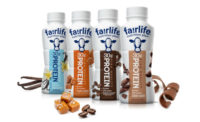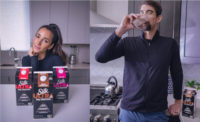When Safeway Foods, Pleasanton, Calif., opted for a “new look” to introduce its 48-ounce ice cream container, it didn’t have to settle for an off-the-shelf preformed package. Working with its current supplier and in-plant systems specialists at Huhtamaki, Safeway went to market with a custom-shaped container. The new, high-impact package with branded graphics used Huhtamaki in-plant forming machines that also enable unmatched production changeover speed and flexibility, along with considerable cost advantages.
“This in-house system and our partnership with Huhtamaki allowed us to respond to marketplace conditions with ease, speed and relatively little expense,” says Ed Olivero, vice president of dairy manufacturing for Safeway. “From start to finish, package design as well as tooling, installation and production was accomplished within six months. Actual conversion of five forming units in both of our ice cream plants was completed within a week and we were feeding new containers directly into the filling lines.”
More than 60 SKUs across a variety of Safeway ice cream product lines are now being sold in the new container, including its Safeway Select signature brand and Lucerne ice cream - both distributed system-wide - as well as regional Eating Right and Jersey Maid brands. Safeway ice cream comes from two production plants: Bellevue, Wash., and Phoenix, Ariz., which employs four Huhtamaki Systems FM-1400 forming machines making the Convocan MX containers.
Safeway is North America’s third largest supermarket chain, operating nearly 1,750 stores primarily in central and western United States and Canada. In addition to the Safeway name, the company operates stores under banners that include Randalls Food Markets and Tom Thumb Food & Pharmacy in Texas, Vons in California and Nevada, and Dominick’s Finer Foods in the Chicago area, as well as Carrs (Alaska) and Genuardi’s on the eastern seaboard.
In-plant system enables rapid, low-cost change to customized container
When the initial request for a new package was received from Safeway’s Strategic Sourcing group, “Our engineering department immediately began developing container design options - some taller and narrower, some shorter - focusing on meeting Safeway’s objective while making the fullest possible use of their existing in-house assets,” says Allison Vande Kieft, sales account manager for Huhtamaki, headquartered in De Soto, Kansas.
“Rather than settle for a ‘stock’ package solution, we made sure Safeway had a custom-tailored container and was able to use current formers with relatively minor adaptations,” Vande Kieft says. “Once the tapered package shape was approved, we could build the precise tooling to form it and complete all other steps necessary to produce it.”
Meanwhile, Safeway used this opportunity to design new graphics for the tapered containers to bring a totally new look to the marketplace. The packaging was then preprinted, die-cut and shipped flat from Huhtamaki to Phoenix and Bellevue, just in time for conversion on the formers.
“The beauty of the Huhtamaki Systems is that we could design an entirely new container, complete the engineering and have the new package up and running within six months, start to finish,” Vande Kieft says.
“What’s more, Safeway doesn’t have to build inventories and stage them for production; the in-house formers feed directly into filling lines. And, because the flat container sidewalls take up so much less space than a preformed option, they can keep some components on the floor and can change packaging on the fly, literally in minutes. If, for example, there’s an issue with the strawberry ice cream, they can quickly start feeding sidewalls of chocolate or another flavor into the unit, pull lids out of inventory and have new cartons moving into the filling line in almost no time.”
Cost savings, on-demand production drive initial shift to in-house system
An early adapter of Huhtamaki Systems, Safeway has been forming its own ice cream containers on-site for years. “As with most customers who go from preformed to an in-plant system, cost reduction and efficiencies in shipping, warehousing and inventory were key factors,” Vande Kieft says.
For one, preprinted and die-cut package sidewalls are shipped flat with about 10 times as much packaging per truckload compared to a preformed container. As a result, in-plant customers typically can save up to 90% in transportation costs. They also see reductions in costly inventory and warehouse space, as well as related equipment, storage racks and labor costs.
From an overall production standpoint, the ability to form containers on-demand and switch flavors or sizes quickly to meet changes in filling line requirements was and still is a major benefit. As previously noted, this flexible system also worked to Safeway’s advantage in implementing its latest packaging concept.
“Conversion was completed and our people were up-to-speed forming the new containers within a week,” Olivero says, adding that “the Huhtamaki in-plant system has served us well for years. The ease, speed and cost-effectiveness with which this new package was developed exemplifies our partnership at its best.”
Huhtamaki is a global leader in the packaging industry, specializing in consumer and food packaging solutions, including rigid paperboard, rigid plastic and molded fiber packaging for a wide range of consumer products, such as frozen desserts, frozen foods, dry food and snacks. Huhtamaki also offers in-plant paperboard and plastic container forming systems, which can streamline user operations, reduce costs and increase production flexibility. The company operates 10 U.S. manufacturing facilities with North American headquarters in De Soto, Kansas. Visit www.us.huhtamaki.com.
For more information, contact Bob Wolff at the Drucker Group at 312/867-4960, or Penny Staats at Huhtamaki at 913/583-8760.
PR Contact
Bob Wolff 312/867-4960
Huhtamaki System Shapes Safeway Packaging Upgrade
Looking for a reprint of this article?
From high-res PDFs to custom plaques, order your copy today!




